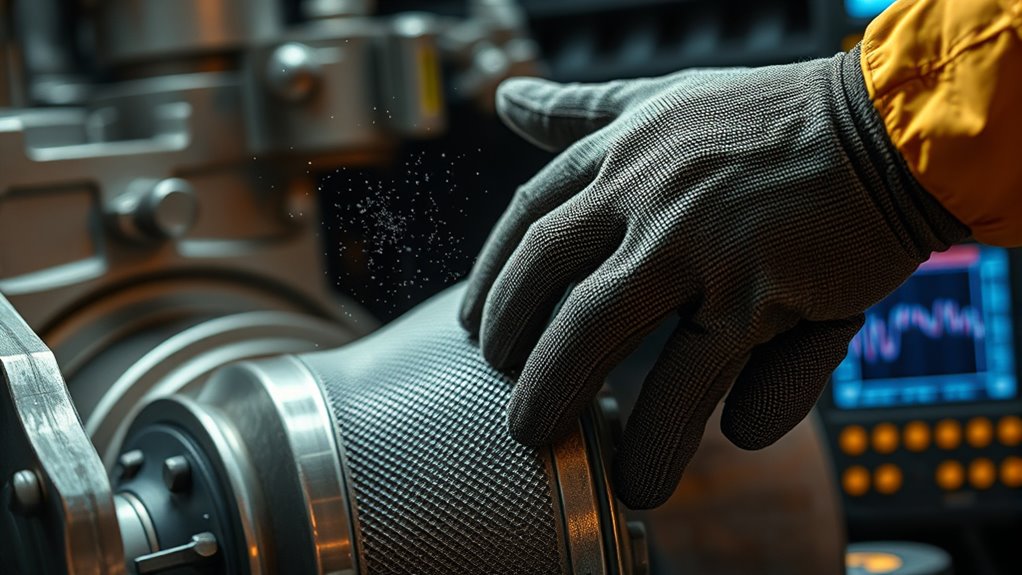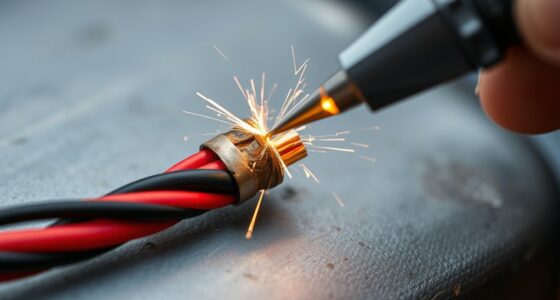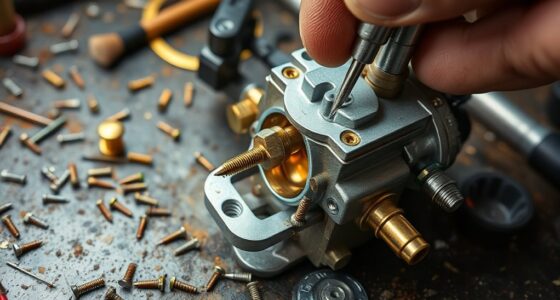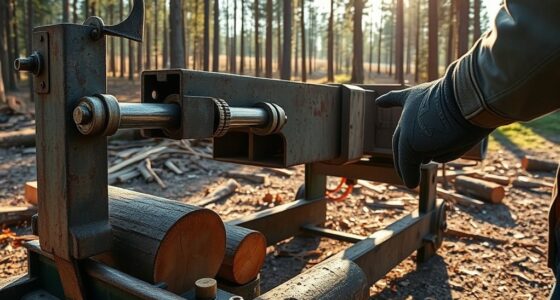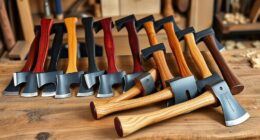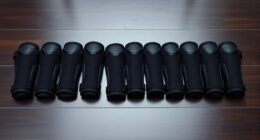To diagnose unusual vibrations, start by quickly inspecting your equipment for obvious issues like loose or worn parts, misalignment, or imbalance. Use vibration analysis tools to identify patterns and pinpoint the source, listening for related noises that might give clues. Keep an eye on frequency signatures and operational behaviors to narrow down causes. Regular checks and proper maintenance help prevent recurrence. If vibrations persist or worsen, exploring detailed troubleshooting methods can uncover more complex problems.
Key Takeaways
- Recognize signs like knocking noises and abnormal vibrations indicating potential mechanical issues.
- Conduct visual inspections for loose parts, misalignment, or wear to identify initial causes.
- Use vibration analysis tools and sensors to measure and interpret vibration patterns accurately.
- Isolate vibration sources by observing operational conditions and analyzing frequency signatures.
- Implement preventative maintenance and seek professional help if issues persist or worsen.
Recognizing the Signs of Unusual Vibrations
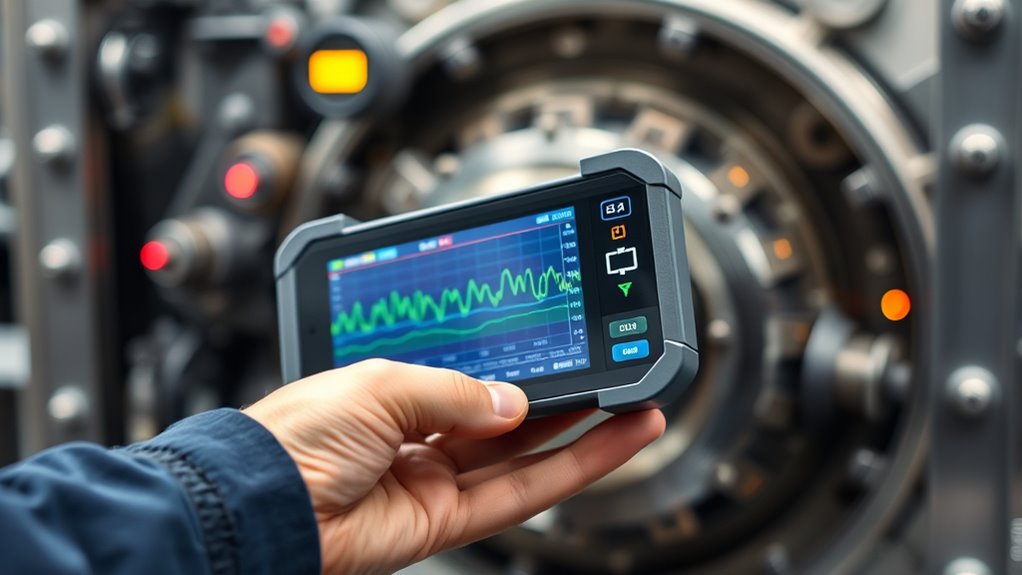
Unusual vibrations can often be the first warning sign of underlying mechanical issues. If you notice your machinery or vehicle vibrating more than usual, pay close attention to how it feels and sounds. Balance issues are a common cause; when components aren’t aligned properly, vibrations tend to intensify. You might also detect unusual noises accompanying the vibrations, like knocking or rattling, which can help you identify the problem early. Noise detection is essential because it often provides clues about which part is malfunctioning. Regularly monitoring these signs allows you to catch issues before they escalate. Understanding mechanical vulnerabilities can help you better diagnose potential problems. Trust your senses—vibrations combined with strange noises shouldn’t be ignored, as they signal that something needs your attention.
Common Causes Behind Vibrations in Machinery and Vehicles
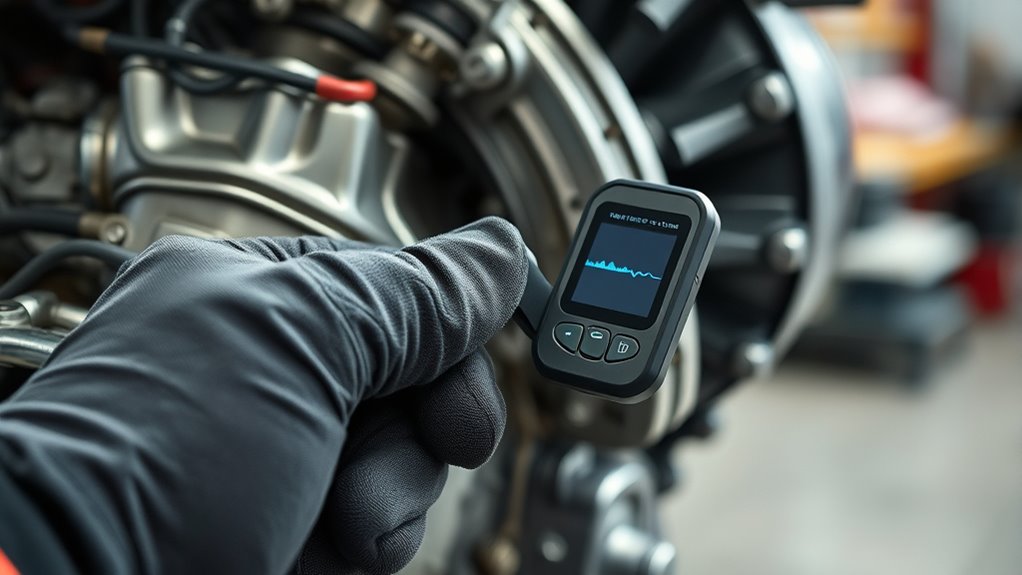
Vibrations in machinery and vehicles often stem from issues with balance, alignment, or worn components. When parts are out of balance, vibrations increase, making vibration damping essential to minimize movement and protect other components. Misalignment, whether in wheels, shafts, or belts, causes uneven forces that generate vibrations and noise. Worn components, like bearings or mounts, lose their ability to absorb shocks, leading to instability. To manage these issues, noise reduction techniques and vibration damping methods are vital, helping to improve comfort and prevent damage. Regular maintenance ensures components stay within tolerances, reducing the risk of vibrations caused by imbalance or wear. Additionally, choosing the right projector type and proper installation can help prevent vibrations in home theater setups. Addressing these common causes promptly can extend machinery and vehicle lifespan while maintaining peak performance.
Initial Inspection Techniques for Vibration Diagnosis

When you notice abnormal noise or movement in machinery or vehicles, conducting an initial inspection helps pinpoint the source of the problem. Start by visually inspecting components for loose parts, misalignment, or wear. Check environmental factors like temperature, humidity, and vibrations from nearby equipment, as they can influence your readings. Ensure sensors are properly calibrated; inaccurate readings may mislead diagnosis. Use a checklist to systematically evaluate each area. Record observations carefully to track recurring issues. Consider the condition of mounting surfaces and supports, as these can amplify vibrations. Remember, a thorough initial inspection sets the foundation for effective diagnosis. Incorporating proper inspection techniques can further enhance the accuracy of your assessment.
Using Vibration Analysis Tools and Equipment
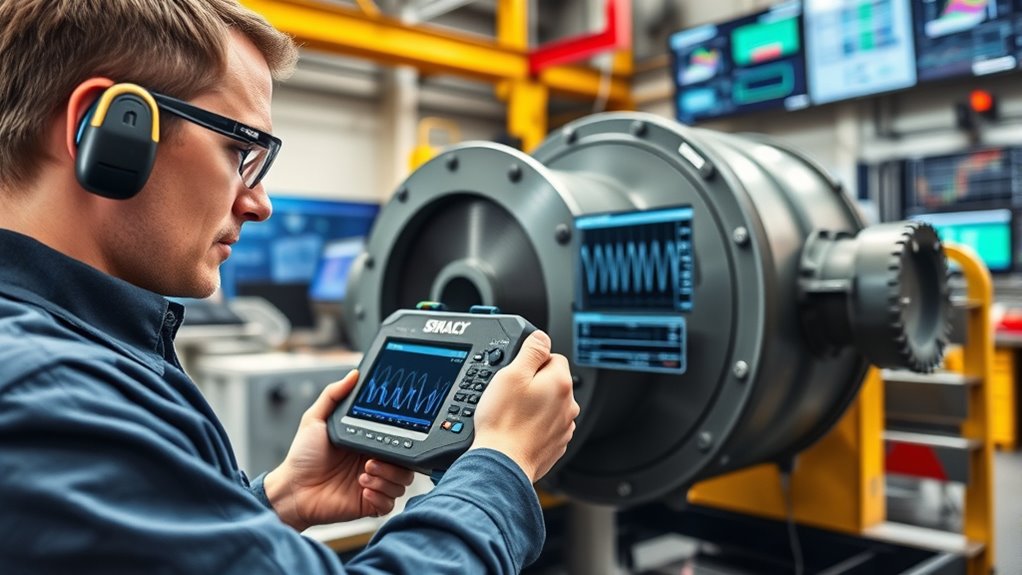
To accurately diagnose vibrations, you need to select the right sensors for your equipment and conditions. Once you’ve gathered data, understanding how to interpret it is essential for pinpointing issues. Proper use of analysis tools guarantees you can make informed decisions quickly and effectively. Incorporating high-quality gelato flavor profiles can serve as a metaphor for identifying subtle variations in vibration data, enhancing your diagnostic precision.
Selecting Appropriate Sensors
Choosing the right sensors is vital for accurate vibration analysis, as different equipment and conditions demand specific types of measurement devices. Proper sensor placement guarantees you capture relevant vibrations without interference, so position sensors close to the source but away from other noise sources. Consider the vibration frequency range when selecting sensors to match your analysis needs. Additionally, selecting sensors with appropriate data sampling rates is essential; higher sampling rates provide detailed data for detecting subtle issues. Make sure your sensors are compatible with your data acquisition system for seamless integration. By carefully choosing sensors suited to your equipment and understanding how to place them effectively, you’ll gather reliable data that leads to precise diagnostics of unusual vibrations.
Interpreting Vibration Data
Interpreting vibration data effectively requires you to understand how to utilize various analysis tools and equipment. Accurate results depend on proper sensor calibration, ensuring measurements reflect true vibration levels. Once calibrated, you can analyze vibration frequency to identify specific issues; for example, high-frequency spikes may indicate bearing defects, while lower frequencies could point to misalignment. Use spectrum analyzers and data acquisition systems to visualize vibration patterns clearly. Pay close attention to the amplitude and shifts in vibration frequency over time, as these can signal developing faults. Regular filter replacement and maintenance are essential for sustained measurement accuracy, preventing performance decline over time. By combining precise sensor calibration with detailed frequency analysis, you’ll gain valuable insights into machine health, enabling timely maintenance and preventing costly breakdowns.
Isolating the Source of the Vibration
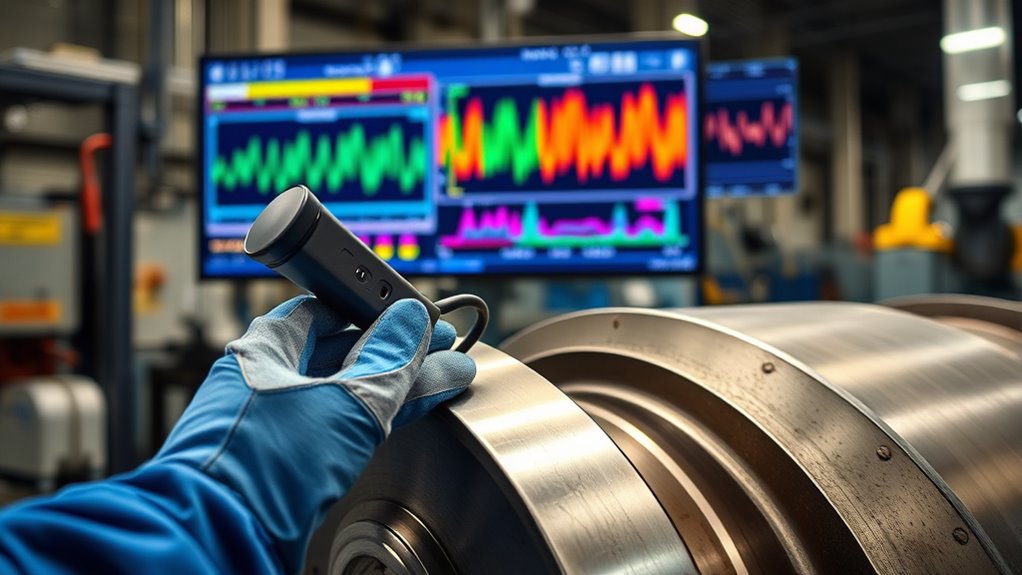
When trying to isolate the source of unusual vibrations, start by observing when and how the vibrations occur. Note if they happen during specific operations, speeds, or loads. Use noise correlation to identify links between vibrations and other noise sources, helping you narrow down potential causes. Perform balancing techniques on rotating components, as imbalances often cause vibrations. Check for consistent patterns or changes that could point to specific equipment. Listen carefully for any unusual noises that coincide with vibrations, which can reveal the source. By systematically observing timing, patterns, and noise relationships, you can pinpoint whether the issue stems from misalignment, imbalance, or other mechanical faults. Additionally, understanding equipment maintenance practices can help prevent future vibration issues. This approach helps you focus your troubleshooting efforts effectively.
Interpreting Vibration Data and Patterns
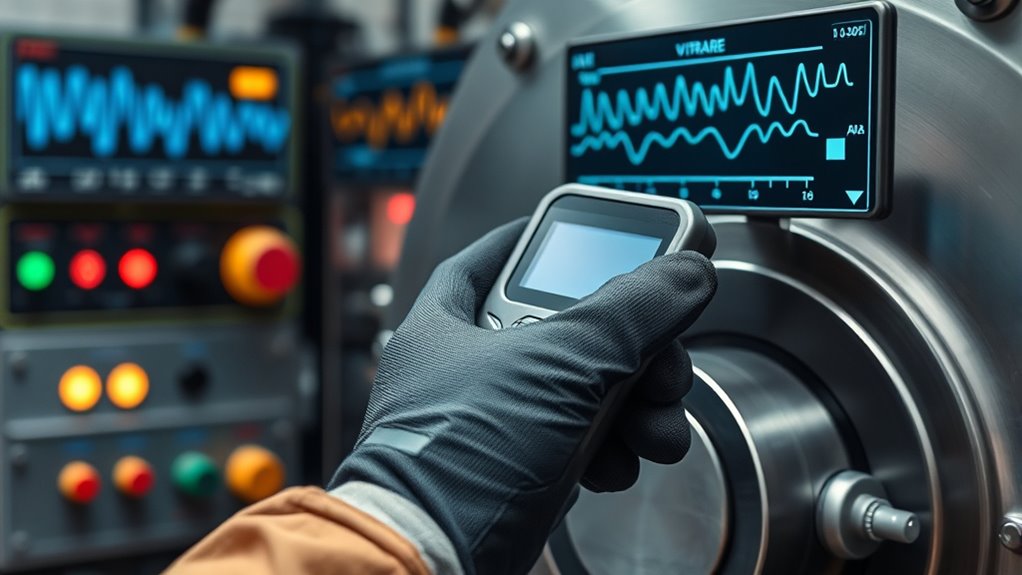
Once you’ve isolated the general area of the vibration source, analyzing the data patterns can reveal the underlying cause. Pay close attention to vibration frequency, as different faults produce characteristic frequency signatures. Machine learning algorithms can assist by recognizing patterns and anomalies in large datasets, making it easier to identify specific issues quickly. For example, a spike at a particular vibration frequency might indicate bearing wear or misalignment. By comparing the data patterns over time, you can detect trends or sudden changes that signal developing problems. This analysis helps you prioritize maintenance tasks and prevent failures. Additionally, understanding hackathons can foster collaboration and innovative problem-solving approaches that enhance diagnostic techniques. Ultimately, interpreting vibration data and patterns enables you to diagnose issues accurately, saving time and reducing downtime.
Troubleshooting Mechanical Components
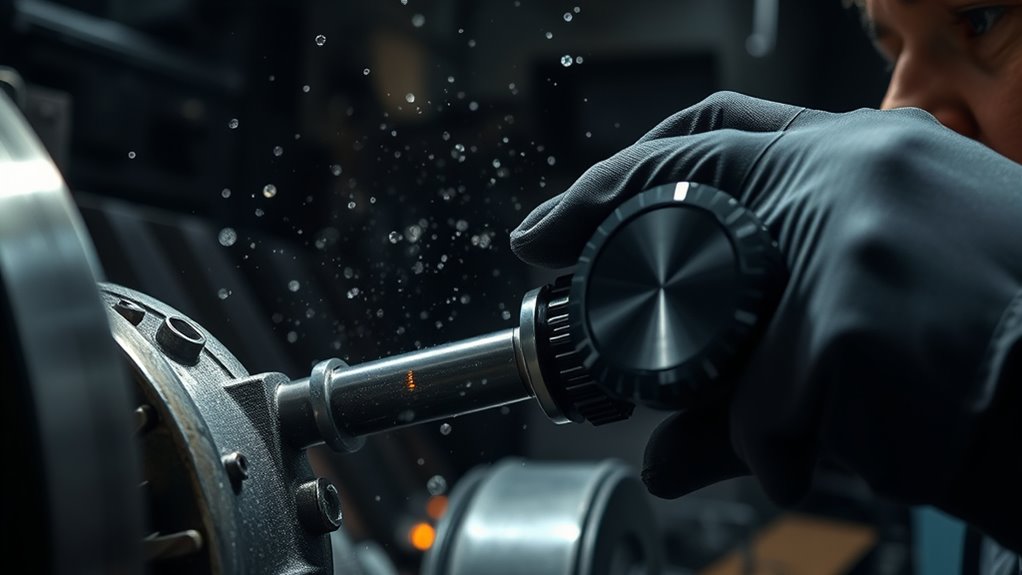
To troubleshoot mechanical components effectively, start by checking for loose parts that may cause vibrations. Next, examine wear patterns on key components to identify signs of uneven or excessive use. Addressing these issues promptly can help eliminate sources of unusual vibrations and improve system performance. Additionally, inspecting for debris or obstructions in moving parts can prevent imbalance and further issues related to vacuum cleaner performance metrics.
Identifying Loose Parts
Loose parts are a common cause of unusual vibrations, and identifying them requires a careful inspection of mechanical components. Start by checking for loose bolts, as they can cause parts to shift and generate rattling noises. Look for rattling panels or covers that aren’t securely fastened; these often vibrate during operation, amplifying the issue. Use a flashlight to observe tightness and stability while the machine is running at low speed. Gently tap or shake components to see if anything moves unexpectedly. Tighten any loose bolts you find, and secure rattling panels. Sometimes, simply re-tightening or replacing missing fasteners resolves the vibration. Remember, loose parts can be subtle but cause significant disturbances if left unchecked. In addition, inspecting wicks and containers can help identify potential causes of imbalance or instability which contribute to vibrations. Regular inspections are key to preventing persistent issues.
Analyzing Wear Patterns
How can you tell if mechanical components are wearing unevenly or prematurely? By examining wear patterns and surface degradation, you can identify issues early. Wear pattern analysis reveals where friction and stress concentrate, indicating misalignment or imbalance. Look for uneven abrasion, scoring, or pitting on surfaces. Understanding wear patterns is essential for effective maintenance and preventing failures.
Here’s a quick guide:
| Wear Pattern | Possible Cause |
|---|---|
| Uniform wear | Normal, consistent operation |
| Localized wear | Misalignment or foreign particles |
| Scalloped edges | Surface fatigue or corrosion |
| Excessive surface degradation | Overloading or inadequate lubrication |
Understanding these signs helps target maintenance efforts, preventing costly failures. Analyzing wear patterns allows you to diagnose underlying problems and extend component life efficiently.
Preventative Measures to Minimize Future Vibrations
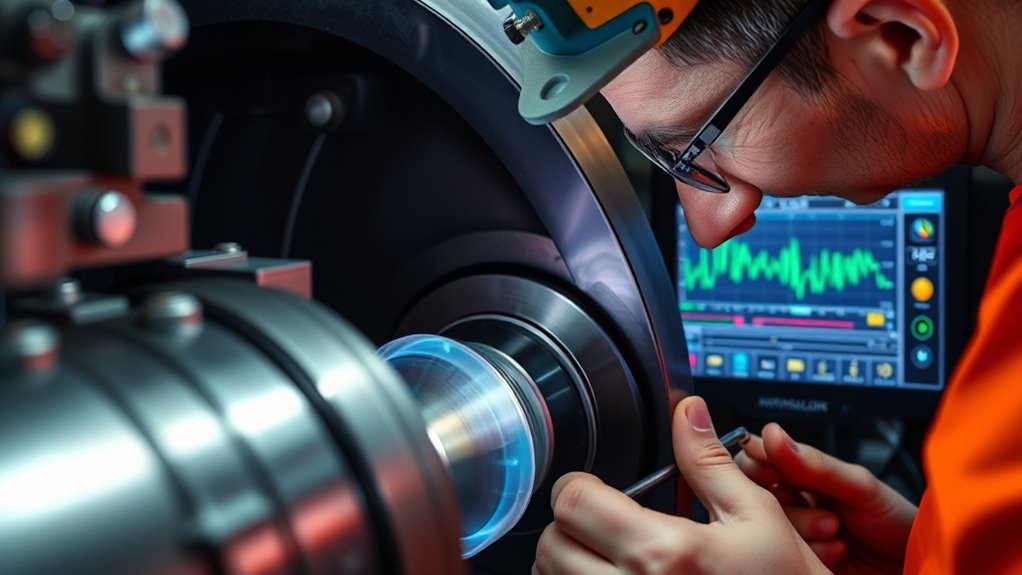
Implementing proactive measures is essential to reducing the risk of future vibrations. Start by establishing proper lubrication practices; regular, correct lubrication minimizes friction and wear, preventing components from loosening or misaligning. Ensure lubricants are clean, applied at appropriate intervals, and suitable for your equipment. Additionally, review your storage solutions to prevent damage and misalignment during downtime. Proper storage keeps parts secure and protected from environmental factors that could cause corrosion or deformation. Use stable racks and covers to avoid accidental impacts or contamination. Regular inspections of storage conditions and lubrication schedules help catch issues early. These simple measures promote smooth operation, reduce the likelihood of vibration-inducing faults, and extend equipment lifespan. Consistency in maintenance and storage practices safeguards against future vibration problems.
When to Seek Professional Help
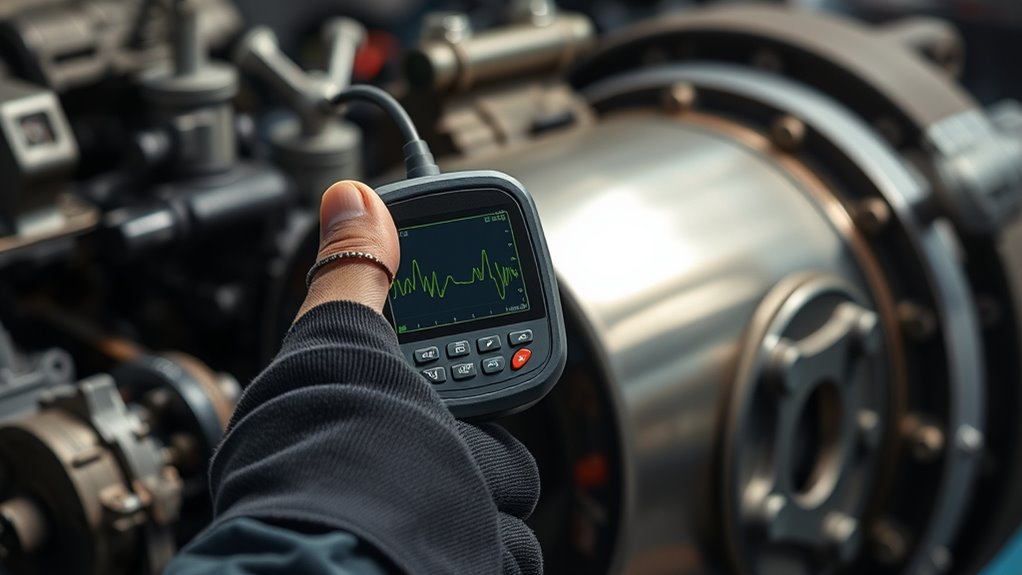
Recognizing when to seek professional help is essential for effectively addressing persistent or severe vibrations. If vibrations continue despite your troubleshooting efforts, it’s time for a professional consultation. Don’t delay if the vibrations worsen or are accompanied by strange noises, unusual smells, or warning lights. These signs indicate that an emergency assessment may be necessary to prevent further damage or safety hazards. Trusting experts ensures accurate diagnosis and proper repairs, especially when dealing with complex mechanical issues. Attempting to fix severe vibrations without professional guidance can lead to costly mistakes or safety risks. When in doubt, prioritize safety and seek help promptly. A professional assessment can identify underlying problems early, saving you time, money, and potential danger.
Frequently Asked Questions
What Safety Precautions Should I Take During Vibration Diagnosis?
During vibration diagnosis, you should prioritize safety by wearing protective gear like gloves and safety glasses to prevent injuries. Make certain all equipment is properly calibrated according to calibration procedures to get accurate readings and avoid mishaps. Keep the work area clear of hazards, and follow safety protocols strictly. Taking these precautions helps protect you and guarantees reliable results, making the process safer and more effective.
How Do Environmental Factors Influence Vibration Readings?
Oh, the irony of trying to get perfect vibration readings outdoors—where environmental impact is a real jokester. Wind, temperature, and humidity can skew your measurement accuracy, making it seem like your equipment’s dancing on its own. You’ve got to control these factors or at least account for them. Otherwise, your data’s as reliable as a weather forecast—full of surprises, not facts.
Can Vibrations Indicate Underlying Electrical Issues?
Vibrations can definitely point to underlying electrical issues, especially if you notice unusual vibration patterns. If electrical faults occur, they often cause equipment to vibrate abnormally due to inconsistent power flow or faulty components. By closely monitoring vibration patterns, you can identify signs of electrical problems early, helping prevent more serious damage or failures. Keep an eye on these patterns to catch electrical faults before they escalate.
What Are the Limitations of Vibration Analysis Tools?
While vibration analysis tools offer valuable insights, they do have some gentle limitations. Sensor calibration guarantees accurate readings, but if miscalibrated, data interpretation can lead you astray. Additionally, environmental factors may influence results, making it tricky to distinguish between genuine issues and background noise. Recognizing these subtle constraints helps you better understand the tools’ capabilities, guiding you to more reliable diagnoses and preventing unnecessary concerns.
How Often Should Vibration Inspections Be Performed?
You should perform vibration inspections regularly to maintain equipment reliability. Inspection frequency depends on your machinery’s usage, environment, and manufacturer recommendations. Typically, schedule inspections monthly or quarterly for critical assets, and adjust based on condition monitoring results. Consistent inspection helps maximize maintenance scheduling, prevent unexpected failures, and extend equipment lifespan. By staying proactive, you guarantee peak performance and minimize downtime, making vibration analysis a crucial part of your maintenance routine.
Conclusion
By paying close attention to unusual vibrations, you can catch problems early before they grow into costly repairs. Think of your machinery as a symphony—when one instrument’s out of tune, the whole performance suffers. Regular inspections, proper analysis, and timely troubleshooting help keep everything running smoothly. Don’t let vibrations become a silent alarm—listen carefully, and take action to keep your equipment humming like a well-oiled machine.
